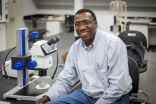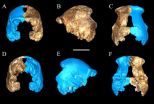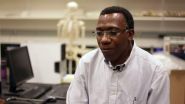(Press-News.org) DENVER (Sept. 10, 2015) - An international team of scientists, including one from the University of Colorado Denver and another from the University of Colorado Anschutz Medical Campus in Aurora, announced the discovery Thursday of a new species of hominin, a small creature with a tiny brain that opens the door to a new way of thinking about our ancient ancestors.
The discovery of 15 individuals, consisting of 1,550 bones, represents the largest fossil hominin find on the African continent.
"We found adults and children in the cave who are members of genus Homo but very different from modern humans," said CU Denver Associate Professor of Anthropology Charles Musiba, PhD, who took part in a press conference Thursday near the discovery inside the Rising Star Cave in the Cradle of Humankind World Heritage Site outside Johannesburg, South Africa. "They are very petite and have the brain size of chimpanzees. The only thing similar we know of are the so-called `hobbits' of Flores Island in Indonesia."
Homofloresiensis or Flores Man was discovered in 2003. Like this latest finding, it stood 3.5 five feet high and seems to have existed relatively recently though the exact age is unknown.
Caley Orr, PhD, an assistant professor of cell and developmental biology at the University of Colorado School of Medicine, analyzed the fossil hands.
"The hand has human-like features for manipulation of objects and curved fingers that are well adapted for climbing," Orr said. "But its exact position on our family tree is still unknown."
The new species has been dubbed Homonaledi after the cave where it was found - naledi means `star' in the local South African language Sesotho.
One of the most intriguing aspects of the discovery is that the bodies appear to have been deposited in the cave intentionally. Scientists have long believed this sort of ritualized or repeated behavior was limited to humans.
The team of 35 to 40 scientists was led by Lee Berger, research professor in the Evolutionary Studies Institute at the University of Witwatersrand in South Africa. It was supported by the National Geographic Society and the National Research Foundation. The October issue of National Geographic magazine will feature the discovery as its cover story. It will also be the subject of a NOVA/National Geographic Special airing Sept. 16.
Getting inside the Dinaledi chamber of the remote cave system was difficult, requiring the help of six `underground astronauts,' who squeezed through a 7-inch wide gap to reach the remains.
"The chamber has not given up all of its secrets," said Berger, a National Geographic Explorer-in-Residence. "There are potentially hundreds if not thousands of remains of H. naledi still down there."
The announcement coincides with the publication of two studies about the new species in the journal eLife, co-authored by Musiba and Orr.
In it, the researchers try to place Homonaledi in context with other species. Generally speaking, they say, there is an assumption that any new group of fossils must belong to an existing species.
But it's not that simple here.
"Assigning these remains to any known species of Homo is problematic," the study said. "While Homo(naledi) shares aspects of cranial and mandibular morphology with Homohabilis, Homorudolfensis, Homoerectus, MP Homo and Homosapiens, it differs from all of these taxa in its unique combination of derived cranial vault, maxillary, and mandibular morphology."
The study suggests that Homonaledi most closely resembles Homoerectus with its small brain and body size. Yet it also resembles Australopithecus which highlights its own uniqueness.
Complicating matters is the fact that researchers still don't know the exact age of the fossil site.
"If these fossils are late Pliocene or early Pleistocene, it is possible that this new species of small-brained, early Homorepresents an intermediate between Australopithecus and Homoerectus," the study said.
That would also make the new species very old.
But if the fossils are more recent, they theorize, it raises the possibility that a small-brained Homolived in southern Africa at the same time as larger brained Homospecies were evolving.
"This raises many questions," Musiba said. "How many species of human were there? Were their lines that simply extended outward and then disappeared? Did they co-exist with modern humans? Did they interbreed?"
Homonaledi has a chest similar to a chimpanzee and hands and feet proportionate with modern humans, though with curved fingers.
"They would have had great climbing ability," said Musiba. "The oldest adults were about 45 and the youngest were infants."
He described poring over the bones late at night as akin to `hitting the jackpot.'
"You just didn't want to go home because it was so exciting," he said. "I felt like a kid in a candy store."
The find represents another milestone in Musiba's efforts to advance the understanding of our earliest human relatives.
As director of CU Denver's Tanzania Field School, he takes groups of students each year to gain hands-on experience working in and around the famed Laetoli hominin footprints site and Olduvai Gorge where some of the oldest hominin remains have been found.
Not long ago, they discovered ancient footprints of lions, rhinos and antelopes near those of the early hominins.
And last year, Musiba was appointed to an international team of advisors dedicated to building a museum complex in Tanzania to showcase a collection of 70 hominin footprints, estimated at 3.6 million years old. They are considered the earliest example of bipedalism among hominins.
Musiba said the Rising Star expedition was notable for getting so many anthropologists to work together.
"Anthropology can be a cut-throat profession with all these scientists scrambling for limited resources," he said. "To me one of the most exciting aspects of this research was the collaborative nature of it."
INFORMATION:
A new study conducted in collaboration with Facebook using anonymised data from the social networking site shows a correlation between people's social and financial status, and the levels of internationalism in their friendship networks - with those from higher social classes around the world having fewer friends outside of their own country.
Despite the fact that, arguably, people from higher social classes should be better positioned to travel and meet people from different countries, researchers found that, when it comes to friendship networks, people from those ...
ATLANTA -September 10, 2015- A new study finds breast cancer incidence and death rates are increasing in several low and middle income countries, even as death rates have declined in most high income countries, despite increasing or stable incidence rates. The findings come from a new report examining global patterns and trends in breast cancer using the most up-to-date cancer registry-based data available. It appears early online in Cancer Epidemiology Biomarkers and Prevention.
Breast cancer is the most commonly diagnosed cancer among all women worldwide overall and ...
Mothers who quit smoking in pregnancy are more likely to light-up again after their baby is born if they feel stressed - according to a new report from the University of East Anglia.
Researchers studied interviews with more than 1,000 new mothers and found that the stress of caring for a newborn, sleepless nights, social pressure, and the idea that they no longer need to protect the baby - all contribute to relapse.
The study also found that women who felt they were being supported by a partner were less likely to start smoking again.
Lead researcher Dr Caitlin Notley, ...
Major European study moves a step closer to treatments for severe asthma
Initial findings from a major European study have helped identify key characteristics of severe asthma, which will help with the development of new treatments for patients with the condition.
The new paper, published online today (10 September, 2015) in the European Respiratory Journal, is one of the largest assessments of adults with severe asthma to date, looking at several characteristics including symptoms, patients' quality of life and blood and airway measurements.
Over 30 million adults ...
A new study in Diabetologia (the journal of the European Association for the Study of Diabetes) is the first to show that high intensity intermittent exercise training improves heart structure and benefits diabetes control in patients with type 2 diabetes. The study is led by Professor Michael Trenell and Dr Sophie Cassidy from Newcastle University (UK) and was funded by the National Institute for Health Research.
People with type 2 diabetes are twice as likely as those without diabetes to have heart disease, and heart disease is the leading cause of death and complications ...
Most men in Europe want to spend fewer hours at work and more time with their families even though it would cut their income, a major study on employment shows.
The common belief that higher-earning men like to work longer to build their careers is shown to be wrong by the study - men who earn the majority of their household's income were most likely to want to work less.
Sociologists Dr Shireen Kanji and Dr Robin Samuel also found that for men breadwinners the attraction of spending more time with their partner is as strong a pull as children's company.
Dr Kanji, ...
PHILADELPHIA - A multiple myeloma patient whose cancer had stopped responding after nine different treatment regimens experienced a complete remission after receiving an investigational personalized cellular therapy known as CTL019 developed by a team at the University of Pennsylvania. The investigational treatment was combined with chemotherapy and an autologous stem cell transplant - a new strategy designed to target and kill the cells that give rise to myeloma cells.
The team's findings are published in a case report today in the New England Journal of Medicine. Prior ...
PHILADELPHIA--Of the more than 50 known lysosomal storage diseases (LSDs)-rare inherited metabolic disorders-only seven can be treated with approved enzyme-replacement therapies. Lysosomal acid lipase deficiency (LALD) is an LSD that causes fatty liver disease and cirrhosis. There is no treatment for the disease, which afflicts 1- 40,000 - 1 in 300,000 people across the world. In this week's New England Journal of Medicine, researchers report results of a trial showing the efficacy of a new enzyme-replacement therapy for LALD. In an accompanying editorial, Daniel J. Rader, ...
Non-small cell lung cancer frequently spreads to the central nervous system (CNS), but patients with CNS metastases may be excluded from clinical trials of new drugs. A University of Colorado Cancer Center study being presented at the 16th World Conference on Lung Cancer reveals the full extent to which the CNS may be under-explored in clinical research.
The study combed the website ClinicalTrials.gov to identify 413 open lung cancer clinical trials. Overall, 41 percent of trials only included patients if their CNS disease was previously treated. Twenty-six percent allowed ...
MINNEAPOLIS - Researchers may have discovered a new marker found in the blood for episodic migraine, according to a study published in the September 9, 2015, online issue of Neurology®, the medical journal of the American Academy of Neurology. Episodic migraine is defined as having less than 15 headaches per month.
"While more research is needed to confirm these initial findings, the possibility of discovering a new biomarker for migraine is exciting," said study author B. Lee Peterlin, DO, with the Johns Hopkins University School of Medicine in Baltimore and a member ...


